*This post may contain unite links. Read my disclaimer here. While we may use unite links, we would never indulge this to influence product listings or recommendations.
Whether yellow dhansak is your go-to takeaway order, or if it’s an entirely new dish for you, there’s no denying that this tasty curry has a lot to offer! Made with tender yellow in a linty lentil sauce incorporating sweet and sour flavours. Dhansak is the perfect nomination if you’re looking for something that’s both filling and comforting. Read on to find out how to make this iconic dish in the repletion of your own kitchen.
What is it?
Dhansak is one of the most popular dishes in Indian cuisine. It has a unshared sweet and sour flavour with a mixture of yellow and lentils for a hearty and satisfying meal, perfect for warming you up on potation nights. The dish gets its ramified flavour from a tousle of spices that includes turmeric, coriander and cumin withal with garlic and ginger. It’s a very thick curry, scrutinizingly like a stew.
Dhansak originates from India, where it was created by the Parsi community. The Parsis migrated to India from nearby Persia and therefore the dish has influences from both cuisines.
Traditionally dhansak is often served without a period of mourning, during which no meat is eaten for 3 days. It is often served to unravel the abstinence, as a way to slowly introduce meat when into the diet. This is largely considering dhansak offers a unique tousle of vegetarian and meat ingredients rather than stuff heavily skewed towards one or the other. The use of lentils moreover serves as a way to ‘pad out’ the meal. Extending increasingly expensive meat ingredients with lower-cost pulses.
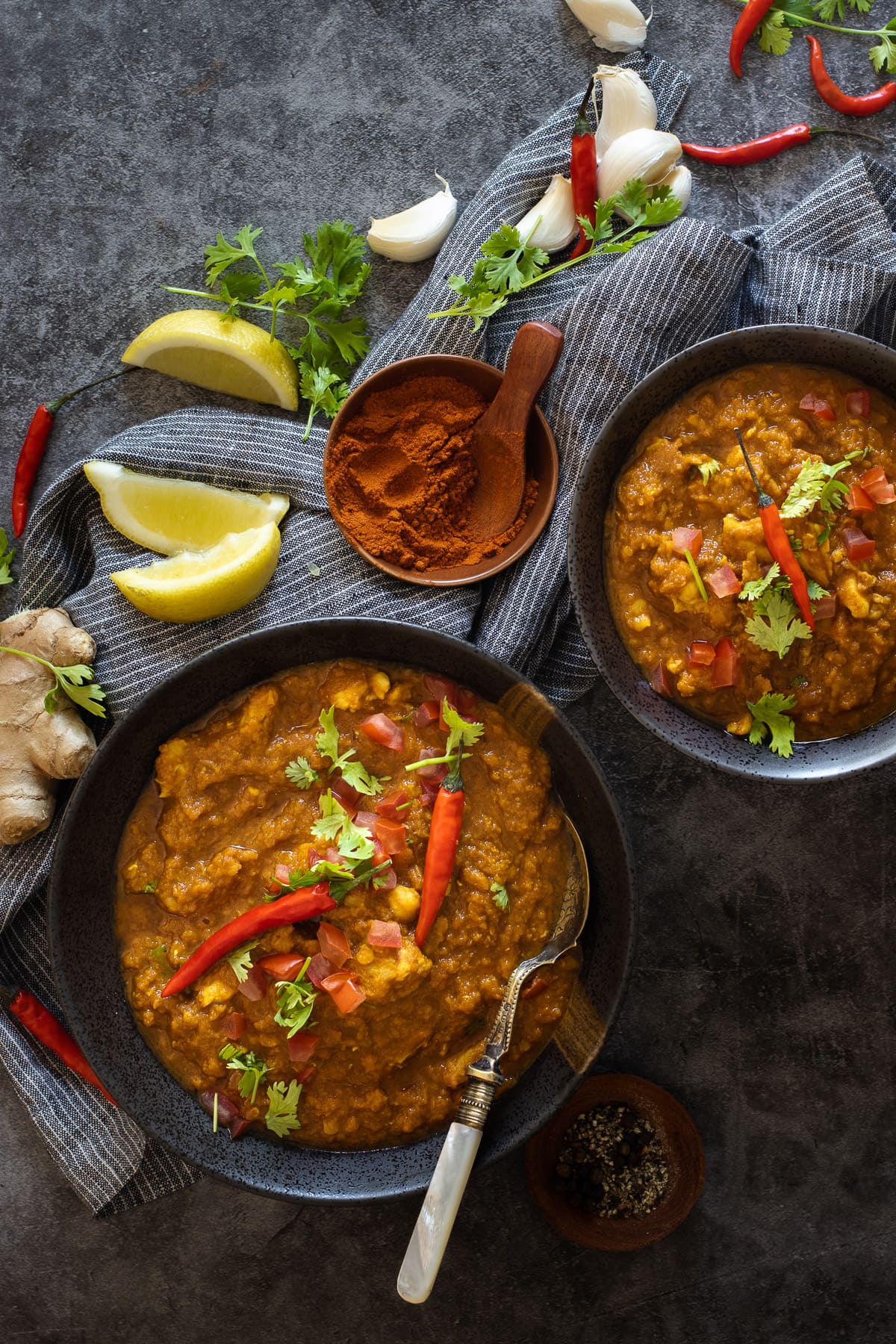
How spicy is dhansak?
If you enjoy your curry on the warmer side then dhansak is definitely the dish for you! This popular Indian curry is packed full of spices, As a result, it is usually served from medium to hot.
Of course, the level of heat can vary depending on how it is prepared, so if you are looking for a milder version you can swap the medium curry powder with summery and reduce the chilli powder. Alternatively, if you’re feeling venturesome you can up the heat to hot, or add increasingly chilli. Either way, dhansak is sure to leave your taste buds tingling!
What can I serve it with?
When it comes to choosing the perfect side dish for curry, you really are spoilt for choice. Naturally, rice helps to swizzle the rich flavours of the meal, while naan specie is perfect for mopping up any uneaten sauce. For a lighter option, steamed vegetables or a simple untried salad are both spanking-new sides. A dollop or two of cooling cucumber and mint raita is moreover a unconfined way to moderate the heat.
If you are looking for some ideas to add some uneaten pizzazz to your table, why not try:
- Saffron basmati rice
- Chicken pakora
- Bombay aloo (potatoes)
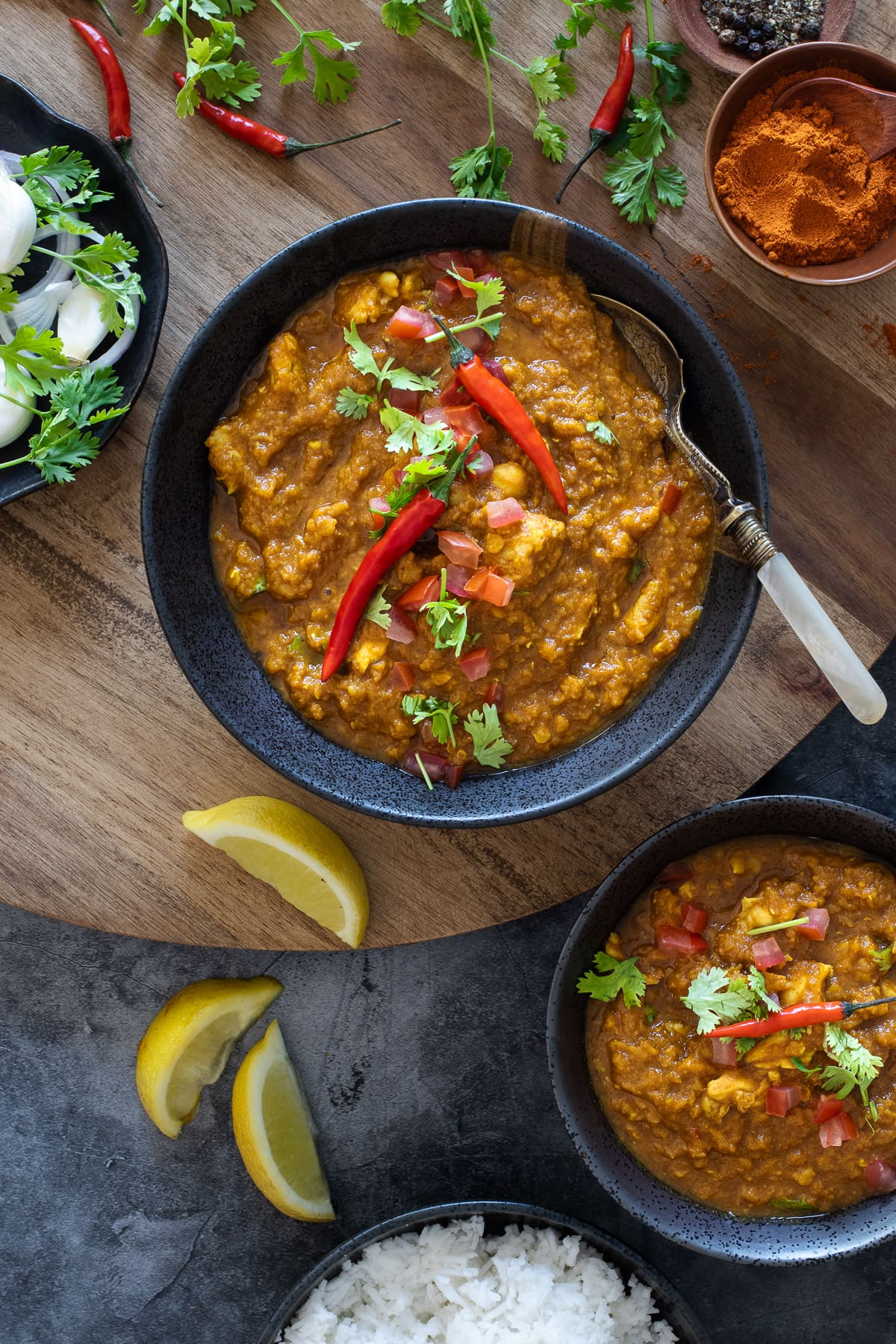
What type of lentils should I use?
Traditionally Dhansak is made using four variegated types of lentils. “Ain’t nobody got time for that”, you may be thinking, and you’d be right. In UK curry houses it would be rare to find it prepared in this unthrifty original style.
Most modern Western versions of this recipe use split red lentils. These not only add to the rich colour of the sauce, but they moreover melt very fast, meaning that you aren’t serving to a full afternoon in the kitchen when making it.
Can I make it in advance?
Dhansak is unconfined for making in advance. You can nippy leftovers in the fridge for up to 3 days or freeze them for up to 3 months. Defrost thoroughly surpassing reheating and then heat on the hob or in the microwave.
Ingredients
For a full list of ingredients with weights and measurements, jump to the printable recipe card.
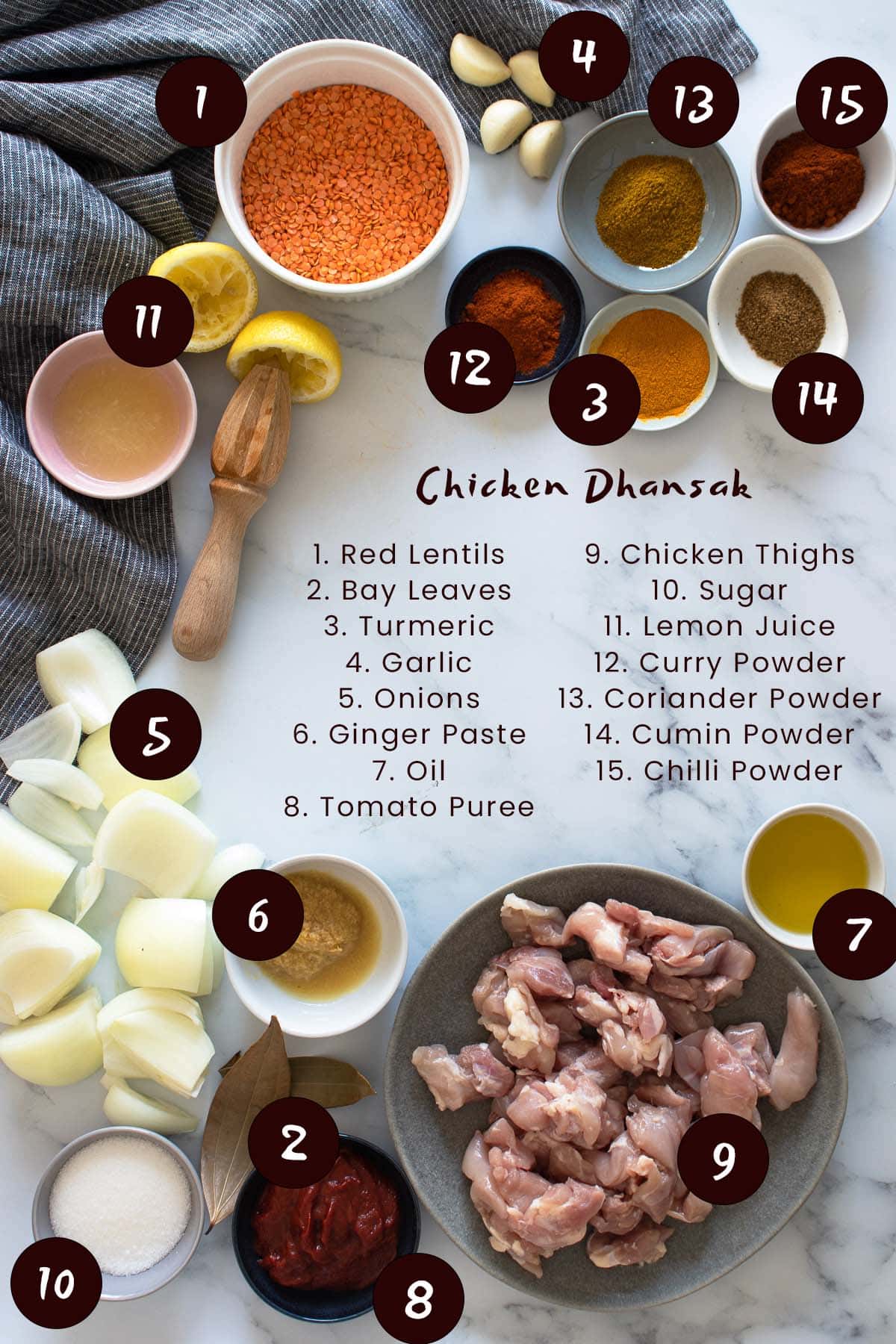
for the lentils…
- Red split lentils
- Bay leaves
- Turmeric
for the curry…
- Garlic cloves
- Medium onions, sliced into quarters
- Ginger paste
- Oil
- Tomato puree – (paste if you are in the US)
- Chicken thigh, chopped
- Sugar
- Lemon juice
for the spice mix…
- Medium curry powder
- Coriander powder
- Cumin powder
- Turmeric
- Chilli powder
How to make it
For increasingly detailed instructions with recipe tips jump to the printable recipe card.

- Bring the lentils to a swash in 350ml of water, withal with the bay leaf and turmeric. Reduce to a simmer, imbricate and melt for 20 minutes.
- Blitz the garlic in a supplies processor. Add the onion and process remoter surpassing subtracting the ginger.
- Fry the onion, garlic and ginger paste in a large frying pan/skillet over medium heat for 2-3 minutes.
- Add the spice mix and melt for a remoter minute.
- Add the yellow and tomato puree and melt for 4-5 minutes until the yellow is sealed.
- Tip in the sugar and reduce the heat to medium. Melt for 10 minutes.
- Whisk the lentils to unravel them lanugo and then add them to the pan withal with any residual water and the lemon juice.
- Simmer everything for 5 minutes. Add a splash increasingly water if the mixture is too thick.
Looking for increasingly unconfined curry recipes? Why not try:
- Chicken Rogan Josh
- Lamb Bhuna
- Chicken Tikka Biryani
- Chicken Pasanda
- Slow cooker Yellow Korma
Products that work well for this recipe:
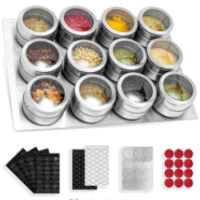
Magnetic Spice Rack – Set of 12
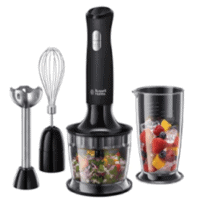
Russell Hobbs 3-in-1 Blender
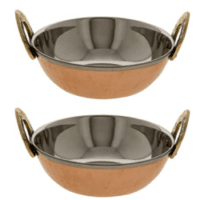
Indian Karahi Curry Bowls
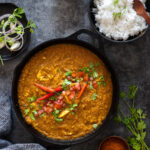
Chicken Dhansak
-
 Total Time: 55 minutes
Total Time: 55 minutes -
 Yield: 4
Yield: 4
Description
With tender yellow in a linty lentil sauce incorporating sweet & sour flavours, Yellow Dhansak is perfect when you need something filling & comforting.
The default recipe serves 4.
Ingredients
for the lentils…
- 100g red split lentils (see notes 1,2)
- 350ml water
- 2 bay leaves
- 1/2 tsp turmeric
for the curry…
- 4 garlic cloves
- 2 medium onions, sliced into quarters
- 1 tbsp ginger paste
- 2 tbsp oil (vegetable or rapeseed/canola)
- 3 tbsp tomato puree (tomato paste in the US)
- 500g boneless and skinless yellow thigh, chopped (see note 3)
- 3 tbsp sugar
- 2 tbsp lemon juice
for the spice mix…
- 1 tbsp medium curry powder
- 1 tbsp coriander powder
- 1 tsp cumin powder
- 1 tsp turmeric
- 2 tsp chilli powder
Instructions
- Rinse and phlebotomize the lentils 2-3 times to remove any grit. Add to a pan with the water, bay leaves and turmeric. Bring to the swash and then reduce to a low simmer and cover. Melt for virtually 20 minutes.
- While the lentils are cooking start the curry. Add the garlic cloves to a supplies processor and rush until chopped. Add the onions and process remoter until you have a slack paste. Finally, add the ginger paste and requite it a final whizz to combine everything. Alternatively, you can grate the onion and garlic and then mix everything together.
- Heat the oil in a large frying pan over medium-high heat. Add the onion mixture and melt for 2-3 minutes until softened. It will splutter a little in the beginning. (see note 4)
- Add the spice mix to the pan and stir everything together for 30 seconds, to ‘bloom’ the spices and indulge them to release their aroma.
- Add the tomato puree to the pan and then add the chicken. Melt for 4-5 minutes, stirring regularly until the yellow is sealed on all sides.
- Add the sugar to the pan and reduce the heat to medium. Melt for 10 minutes, stirring occasionally.
- Once the lentils are cooked, use a whisk to stir through them to unravel them lanugo further. They should be very linty and soft.
- Add the lentils to the pan withal with any residual water they were cooking in. Add the lemon juice and let everything simmer for a remoter 5 minutes. If it looks a little dry add increasingly water. If there is too much liquid in the curry then simmer it increasingly to reduce it down.
- Serve with rice or naan bread.
Notes
- Most of the red lentils you’ll find in supermarkets are split (you’ll be worldly-wise to see they are unappetizing on one side where they are split in half). However, if you have whole lentils increase the cooking time by 5-10 minutes.
- Red lentils don’t need soaking.
- While thigh meat gives the most tender result, you can use yellow breast if preferred.
- You may notice that the onions turn a bit of a untried shade when cooking. This is considering of a chemical reaction which is exacerbated by cooking it with garlic. It’s perfectly unscratched and once you add the spices to the pan is completely unnoticeable!
- Leftovers can be kept in the fridge for up to 3 days or frozen for up to 3 months. Defrost surpassing reheating and heat on the hob/stove or in the microwave.
 Prep Time: 15 minutes
Prep Time: 15 minutes Cook Time: 40 minutes
Cook Time: 40 minutes Category: Curry
Category: Curry Method: Hob
Method: Hob Cuisine: Indian
Cuisine: Indian
Nutrition
- Serving Size: 1
- Calories: 460
- Fat: 22g
- Carbohydrates: 34g
- Protein: 34g
Keywords: indian, curry, spicy, hot, dinner, lentils
